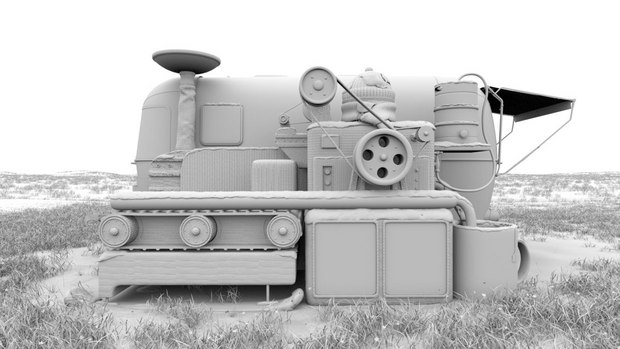Paris’ NAKED Compagnie and New York’s ROOF Studio team up in the Cloud to produce a prolific series of eight second CG bumpers.
One of the most difficult tasks an ad agency faces is creating attention-catching visuals that simultaneously tell a compelling story about a brand or product, usually in the span of a few seconds. For French television network TF1, the task of developing a rebranding campaign was handed off to Paris-based graphic and motion design studio NAKED Compagnie, who then teamed with New York-based production company ROOF Studio to design and produce a series of 45 eight-second commercial bumpers in only five months. The CG spots, depicting various whimsical and humorous mechanical worlds and contraptions, were done using a cloud-based pipeline that allowed real-time collaboration across the globe. We recently spoke to ROOF’s co-founders Vinicius Costa and Crystal Campbell about the project.
Dan Sarto: How did the project come about?
Vinicius Costa: NAKED Compagnie in Paris contacted us to help them create a series of bumpers for TF1 Pub in France. We were really excited about the concept they proposed and how we would be creating a unique little world for each one.
DS: How long did the bumpers take to make? How big was your team? Can you tell us a little about the production?
Crystal Campbell: The bumpers took about five months in total to produce. In addition to NAKED’s team in Paris, we had about 30 different artists working the majority of the project, as well as our team in New York City. Our pipeline was set up in the cloud and we were able to work with incredibly talented artists from around the globe.
DS: Describe the creative design and look development process.
VC: NAKED first brought us concepts for the initial bumpers and then we all worked together to design the following spots. Sometimes we would bring up concepts and then would brainstorm with NAKED to really flush out the ideas. Once we had an approved design, we would jump straight into modeling, then animation, render, etc.
CC: Once we had approved designs, we mainly focused on details for creating something really special on each bumper. If you look closely, you can see we added hints of scratches, colors, or variations to all the textures. Everything is incredibly detailed and it adds a realness to these little worlds. As you watch them over and over, you discover some new detail each time. We are really proud of them.
DS: How were the spots produced? Can you share some details regarding the main digital tools and techniques used?
VC: We used Modo, Maya and Arnold and set up a production process with Amazon and Podio to work in real time both internally and externally. With more than 30 people working on the project at any given time, it was really important for us to have a really strong structure. Podio was really strategic and a lot of help with efficiencies. Artists could speak directly with one another in its Facebook structure. You could also visibly see the status of each phase on each individual bumper. Once we were ready to render, we set up a lot of the renders in the cloud with Amazon. This allowed us to free up our farms for testing and any high priority renders. It was really amazing to see everything come together technically and for the pipeline to handle all of the files.
DS: What were the biggest challenges you faced making these spots?
CC: The sheer number of bumpers was very challenging. We needed to be very organized with our pipeline and then of course make sure it would be set up properly to render everything in a timely manner.
--
Dan Sarto is Publisher and Editor-in-Chief of Animation World Magazine.
Dan Sarto is Publisher and Editor-in-Chief of Animation World Network.



















